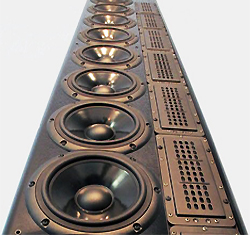Since the early 1980s, the term “time alignment” has been tossed around pretty freely, and with dubious degrees of accuracy.
Note, however, that this was far from the first time the concept was noticed. Indeed, the engineers who provided the loudspeakers for the first “talkie” film, Al Jolson’s The Jazz Singer, noticed that the “taps” of the tap dancing scenes came out of the high-frequency (HF) horn and folded-horn low-frequency (LF) woofer at different times.
Ever since, designers have been trying to time-align loudspeakers. The phrases “time align,” “time aligned,” and “time alignment” are trademarks of E. M. Long, the inventor of the famous UREI 813 monitor loudspeaker used in recording studios. Thus for purposes of this discussion, we’ll use generic term “signal alignment” to avoid having to use those ®;’s and ™’s.
Most folks believe that signal alignment between drivers in a loudspeaker cabinet is a matter of measuring the difference in distance to the front of the cabinet from each of the driver’s voice coils. Then, by adding delay to the driver closest to the cabinet delay that corresponds to the difference the signal of all drivers will then be aligned properly.
However, this is not correct! We must understand both filters and phase to properly signal-align HF and LF drivers.
All filters “rotate” phase, causing a positive “phase-shift” to the frequencies that pass through them. Because 360 degrees of phase-shift equals one wavelength, and wavelength can be described in terms of distance or time, any phase-shift at a given frequency can be described as a signal delay of an exact length of time.
For example, because 1000 Hz is 1000 cycles per second, one wavelength (or cycle) is 1/1000th of a second, or 1 millisecond (ms). Therefore, 360 degrees of phase-shift at 1 kHz is 1 ms of delay. Then 180 degrees of phase-shift (1/2 wavelength) is 0.5 ms of delay and 90 degrees (1/4 wavelength) is 0.25 ms of delay at 1 kHz. For 2 kHz, because the wavelength of a cycle is one-half as long, then the phase-shift delays would all be one-half the time of delay. At 20 Hz, 180 degrees of phase-shift (1/2 wavelength) is 25 ms, or 28.25 feet of delay at the speed of sound.















